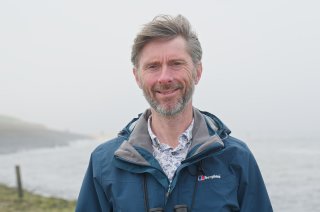
“The potential of the North Sea is enormous”
The North Sea has become an ‘anthropogenic sea’: one in which almost all natural processes are influenced by human activities. The nature transition is an attempt to restore its ecological balance.
- Unfortunately, your cookie settings do not allow videos to be displayed. - check your settings
Nature transition
The names applied to the various North Sea transitions usually make it pretty clear what they’re about. The food transition focuses on sustainable fisheries and aquaculture, and the energy transition is about offshore wind farms as a way of reducing our dependence on fossil fuels. But the term ‘nature transition’ is actually a curious one. It suggests that the nature of the North Sea needs to change and become something different and new in the future. Ordinarily the idea of restoring biodiversity refers to how things used to be.
Martin Baptist and Oscar Bos, both marine ecologists at Wageningen Marine Research, love talking about the type of natural life found in the North Sea ‘back in the day’. “There are old photos of tuna being brought ashore, measuring several metres,” says Baptist. “The Dutch North Sea was also home to the common skate, a gigantic ray that could reach nearly three metres. The grey whale was also found here.”
Cod measuring a metre in length weren’t exceptional in the North Sea once.
“The populations of grey seals, thresher sharks, starry smooth-hound
sharks and dogfish were much greater than now,” adds Bos. “Flat oysters created
huge reefs of up to 35,000 square kilometres, providing an important habitat
for many other species. Cod measuring a metre in length weren’t exceptional
then. Of course, when we talk about ‘back then’, there’s always the question of
how far back you go. But it does give us a sense of what we’ve lost, and
inspiration to strive for nature restoration.”

Marine meadow
Although the North Sea has been fished for centuries, human pressure on the ecosystem became a particularly significant factor at the time of the Industrial Revolution. “Once train tracks were in place, oysters could be exported to major cities in France and Germany,” says Baptist. “From then on, things moved rapidly and by the early 20th century, oysters had already disappeared.”
What remains is a drastically impoverished ecosystem. According to Baptist, the North Sea has become an ‘anthropogenic sea’: one in which almost all natural processes are influenced by human activities. “The effects of bottom trawling create favourable conditions for opportunistic benthic species. That’s good for sole and plaice, which happen to be the fish that are of commercial interest to us. It’s akin to a pasture where we keep animals that we periodically take away to eat. Without that frequent disturbance to the seabed, some places would become much more like a lush carpet with tubeworms, hydrozoa, anemones and nudibranchs.”
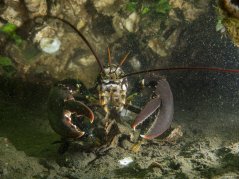
And yet the North Sea is one of the richest, most productive seas in the world. “The North Sea is a continental shelf sea, relatively shallow, and it’s fed by rivers such as the Rhine and Thames, which bring a lot of nutrients. These are all advantageous conditions, and so the potential of the North Sea is enormous. But then we do have to be ecologically responsible in the way we use it.”
Unforeseen effects
All sorts of efforts are being made to reduce the pressure on the ecosystem of the North Sea, and collectively those efforts are known as the ‘nature transition’. Nature conservation organisations advocate setting aside 30 percent of the Dutch North Sea as a nature reserve; the North Sea Agreement eventually set this at 15 percent, something that’s supposed to be achieved by 2030. By then, bottom trawling will be prohibited in those protected areas, which include parts of the Frisian Front, Dogger Bank, Cleaver Bank and Borkum Stones.

“There are also other measures such as management plans for specific species and a monitoring programme for the ecological carrying capacity of the North Sea,” says Bos. “Wind farms often also include ‘nature-inclusive’ solutions, such as the creation of extra reefs around the base of the piles, with larger stones providing places for marine life to hide. The hard substrate at the base of wind turbines is itself a relatively new, stony habitat in the North Sea, so as an ecologist, I’m curious to see what species will benefit from it.”
These days there are numerous regulations in place to reduce the environmental impact of economic activities at sea. “In the past, drilling fluids used to be discharged from oil platforms straight into the sea, and if you walked along the beach, you often got tar on your boots,” says Baptist. “That’s all changed now. The pressure exerted by the fishing industry is also decreasing due to various regulations and because the fleets are getting smaller. Interestingly, this in turn produces new unforeseen ecological effects: the swarms of gulls that used to follow the fishing boats because so much fish was thrown overboard now have a harder time of it. Like I said, it’s an anthropogenic sea.”
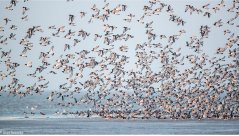
The question of whether all these measures are enough to restore the ecological balance will generate a range of answers, depending on who you ask. Conservationists argue that at least 30 percent needs to be protected to maintain a marine ecosystem. Wageningen Marine Research says that’s something it needs to research. “Studies are done on the effects of quotas on the fish we like to catch. But there are over 200 fish species in the North Sea, and for many of them, we barely have any idea of how populations are developing. The policy focus is mainly on those species that have commercial value.”
Warmer seawater
There’s another factor at play, which is that ecological effects might change as economic activities are scaled up. “There are currently hundreds of wind turbines in the North Sea, but by 2050 there will be 5,000,” says Baptist. “Or look at sand extraction. It changes the shape of the seabed, water movements and silt trapping, and of course it kills a lot of marine life. These effects are mainly local right now, but sea levels are rising and we need more and more sand for dunes and sea dykes. Plus there are plans to extract sand from deeper pits in future, up to 12 metres deep. Ecological impacts that seem manageable now may not be so manageable in the future.”
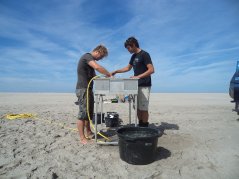
And then there’s climate change, of course. That, too, is a consequence of human activity, and is having a major impact on marine ecosystems. “The North Sea is warming up and that’s bad news for some species and good news for others,” says Bos. “Cod are migrating away, while sea bream and sea bass are actually heading towards us from more southern regions.”
Warmer seawater has all kinds of effects on the behaviour, physical development and reproduction of marine life. For example, fish start spawning earlier in the year. “This can create a mismatch with food supply,” says Bos. “Algae, for example, might not yet be blooming, which means there isn’t much zooplankton for young fish to eat. The timing is then out of whack and the whole system falls apart. On top of that, if the seawater temperature rises, fish become more active. They consume more energy and therefore need more food, which in turn changes the predation pressure exerted by those species.”
Baptist adds: “Most animals in the North Sea are cold-blooded. Their entire physiology is driven by the temperature of the seawater. So if that temperature increases, you can imagine how there would be all kinds of profound consequences.”
Worms and robots
As with the food transition and the energy transition, Wageningen Marine Research is supporting the nature transition with numerous studies, providing data and insights to support policy. “For example, we’re studying the energy systems of fish, using dynamic energy budget models,” says Baptist. “We’re also conducting research in areas such as zooplankton, the presence of plastic in the stomachs of fulmars, and Sabellaria reefs. Those reefs are created by worms that build tubes around their bodies using grains of sand and bits of shell. The tubes can grow into large sandstone reefs – effectively natural 3D structures in the North Sea. Sabellaria worms are real ecosystem engineers.”

Biodiversity around wind farms is also being monitored. “We can now use a robotic arm to scrape growths off wind turbine poles and put them in a jar to be analysed later in the lab to see what species are present,” says Bos. “We also work with companies that can use underwater drones to properly monitor nature-inclusive reefs and the dumping of rock armour. In other locations where there are oyster reefs or interesting seabeds, AUVs – autonomous underwater vehicles – can be used. These are robots, shaped like torpedoes, that provide images of the seabed. Lobster Robotics, for example, has taken thousands of photos of the seabed at the oyster reef in the Voordelta, and compiled them into 20x20-metre images. This immediately gives us a great insight into the biodiversity and structure of the reef. In the past we would have had to rely on cameras that could only show a small section.”
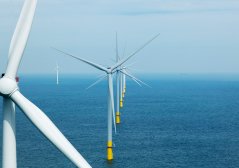
So what do the two ecologists think needs to happen if we want to design all these economic activities in the North Sea in such a way that the ecosystem can rebalance itself? “In practice, sustainable use of the North Sea requires a lot of knowledge,” says Baptist. “In particular, it’s about the sum of all those factors – wind farms, climate change, fishing – and the interaction between them.”
“And it’s important for each economic activity to be given its own place,” says Bos. “That means ensuring that some areas really are designated as nature areas. Every type of activity involves endless consultation between stakeholders, but there comes a point when we have to very clearly agree that this is a nature reserve, we’ll leave it alone, and you’re not allowed to do anything there for a while.”
Ecological impacts that seem manageable now may not be so manageable in the future.
Overall, there will be an ongoing need for ecological research. “We know that the North Sea is one of the most productive seas in the world,” Baptist concludes, “but we also know that the North Sea is one of the busiest seas in the world. There’s intensive shipping, fishing and energy generation – and it’s all being done by a number of countries with sometimes different interests, all in the same sea. There will always be a tension between the potential of the North Sea and how crowded it is. We need to make sure this is well managed, now and forever.”